-
Countries
-
Data and Analysis
-
Special Focus
-
Crisis Responses
Displacement Report (IDPs & Returnees)
Country
Title Standard
Libya — IDP and Returnee Report {#} ({DATE})
Operation
Contact
DTM Libya, DTMLibyateam@iom.int
Type
Component
Domain
Confidential
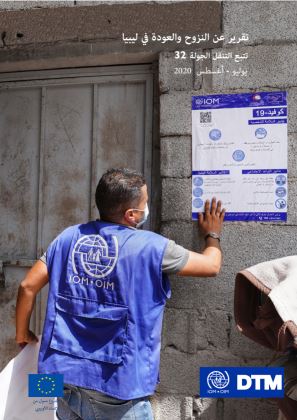
Contact
DTM Libya, DTMLibyateam@iom.int
Language
Arabic
Location
Libya
Period Covered
Jul 01 2021
Aug 31 2021
Activity
- Mobility Tracking
- Baseline Assessment
يستعرض هذا التقرير نتائج الجولة الثانية والثلاثين المستخلصة من عمل وحدة تتبع التنقل الخاصة بمصفوفة تتبع النزوح في ليبيا والتي تغطّي الفترة الممتدة بين شهري يوليو وأغسطس من سنة 2020. وخلال فترة الدراسة، لوحظ انخفاض كبير في حالات الاشتباك المسلّح في ليبيا (يرجى الاطلاع على الصفحة السادسة من هذا التقرير). وعقب توقّف الأعمال العدائية في جنوب طرابلس، بادرت الأسر النازحة بالعودة تدريجيا إلى مساكنها، على الرغم من غياب الخدمات الأساسية ومن وجود مخلّفات الحرب وذخائر غير متفجرة في المناطق المتنازع عليها سابقا والتي كانت سبب امتناع العديد من النازحين عن العودة إلى مناطق أصلهم. هذا وقد ارتفع عدد العائدين خلال هذه الجولة من 456.728 إلى 493.716 عائدا تم إحصاء أغلبيتهم في أبو سليم والعزيزية والسبيعة وسواني بن آدم و مناطق أخرى من عين زارة.

Contact
DTM Libya, DTMLibyateam@iom.int
Language
English
Location
Libya
Period Covered
Sep 01 2020
Oct 31 2020
Activity
- Mobility Tracking
- Baseline Assessment
This report presents the findings of round 33 of the Mobility Tracking component of IOM Libya’s Displacement Tracking Matrix (DTM) programme, covering September – October 2020. During the reporting period, the cessation of hostilities and progress made towards peace resulted in a ceasefire agreement between the conflicting sides, as a result an increasing number of previously displaced families returned to their places of origin in Western Libya due to improved security situation.
The number of returnees identified during this round of data collection increased from 493,716 returnees identified in round 32 to 567,802 returnees in round 33. During round 33 the number of returnees identified in
Tripoli region increased by 32,251 individuals to a total of 114,137 returnees with the municipalities of Abusliem and Ain Zara accounting for most new returnees. Similarly, the number of returnees in municipalities in Aljfara region south of Tripoli (e.g. Swani Bin Adam, Espeaa, Aziziya, Suq al Khamees) increased by 57,400 to a total of 86,370 returnees.
As a significant proportion of these returnees had returned to their houses in the previously conflict affected municipalities of Qasr Bin Ghasheer, Espeaa, and Swani Bin Adam in Aljfara, and in the Tripoli municipalities of
Abusliem and Ain Zara’s southern areas, DTM initiated a rapid returnee household survey in one area of return (Qasr Ben Gashir) to better understand the return dynamics and challenges faced by returning IDPs in their places of origin. Initial findings from this quick returnee household survey are also covered in this report. Most notably, only one fifth (19%) of interviewed families reported no damage to their housing, while the majority (58%) reported minor to moderate damage and 23% indicated that their houses had been severely damaged by the armed conflict. Limited public services, such as intermittent electricity and water supply, where also highlighted as key challenges.
During the months of September - October 2020 the trend of decline in new displacements observed in the previous round of data collection continued. As a result due to returns the number of internally displaced persons
(IDPs) identified in Libya decreased from 392,241 individuals reported in round 32 to 316,415 IDPs identified to be still displaced in round 33.
Furthermore, this report also includes a summary of COVID-19 related findings from IOM’s consultations with IDPs and members of the host communities in sixteen municipalities in Libya, conducted on behalf of
the UN Secretary-General’s High-Level Panel on Internal Displacement.

Contact
DTM Libya, DTMLibyateam@iom.int
Language
English
Location
Libya
Period Covered
Jul 01 2020
Aug 31 2020
Activity
- Mobility Tracking
- Baseline Assessment
This report presents the findings of Round 32 of the Mobility Tracking component of IOM Libya’s Displacement Tracking Matrix (DTM) programme, covering the reporting period from July to August 2020. Following the suspension of hostilities in South Tripoli, a slow return of some displaced households was observed in Western Libya, although the lack of basic services combined with the presence of explosive remnants of war (ERW) and unexploded ordnance (UXO) in previously contested areas has so far hindered most displaced families from returning to their areas of origin. The number of returnees identified during this round of data collection increased from 456,728 to 493,716 returnees compared to the last round, with returns being observed primarily in Abusliem, Swani bin Adam, Al Azizya, Espeaa and parts of Ain Zara.

Contact
DTM Libya, DTMLibyateam@iom.int
Language
Arabic
Location
Libya
Period Covered
May 01 2020
Jun 30 2020
Activity
- Mobility Tracking
- Baseline Assessment
يستعرض هذا التقرير نتائج الجولة الواحدة والثلاثين المستخلصة من عمل وحدة تتبّع التنقل الخاصّة بمصفوفة تتبع النزوح في ليبيا والتي تغطّي الفترة الممتدة بين شهري مايو ويونيو من سنة 2020 . وخلال هذه الجولة، ارتفع عدد النازحين داخليا في ليبيا من 401.836 نازحا إلى 425.714 نازحا. وتعود حالات النزوح الجديدة خلال الفترة المشمولة بالتقرير إلى ازدياد حالات الاشتباكات المسلّحة في غرب ليبيا والمرتبطة بالنزاع المسلح وبانتقال السيطرة على المناطق. وخلال شهري مايو ويونيو نزح الأفراد النازحون سابقا من ترهونة وسرت إلى بلديات أخرى من شرق ليبيا. وفي سياق الاشتباكات المسلحة المتواصلة داخل طرابلس وحولها والتي نشبت منذ شهر أبريل من سنة 2019
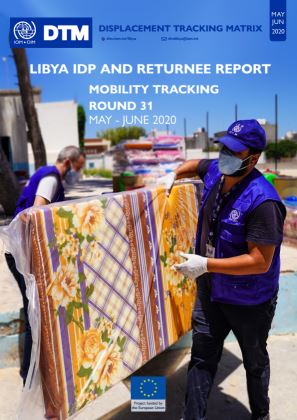
Contact
DTM Libya, DTMLibyateam@iom.int
Language
English
Location
Libya
Period Covered
May 01 2020
Jun 30 2020
Activity
- Mobility Tracking
- Baseline Assessment
This report presents the findings of Round 31 of the Mobility Tracking component of the Displacement Tracking Matrix (DTM) programme in Libya, covering the reporting period from May to June 2020. In Round 31, the number of internally displaced persons (IDPs) identified in Libya increased from 401,836 to 425,714 IDPs. New displacements during the reporting period were primarily driven by increased insecurity in western Libya related to armed conflict and change of control over territory. During May and June 2020 IDPs from the areas of Tarhuna and Sirt displaced to various municipalities of Eastern Libya.
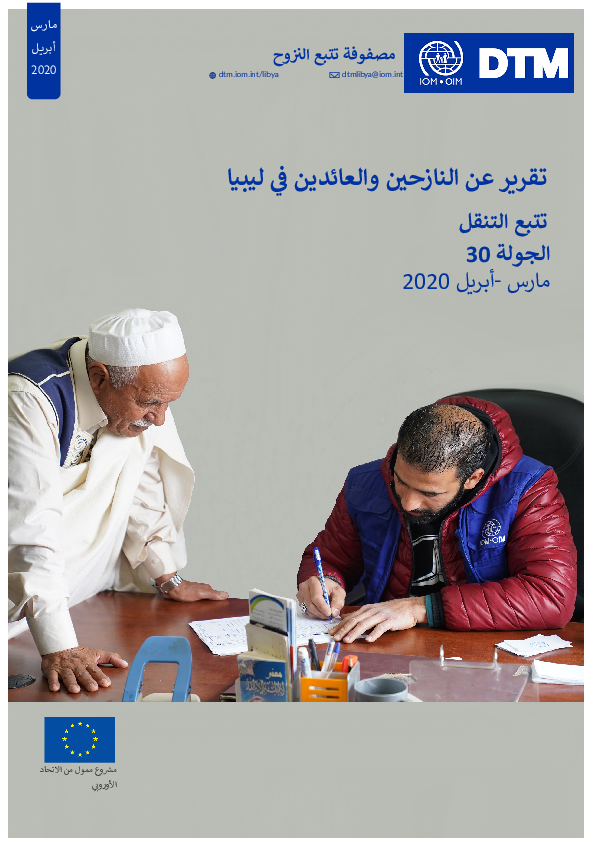
Contact
DTM Libya, DTMLibyateam@iom.int
Language
Arabic
Location
Libya
Period Covered
Mar 02 2020
Apr 30 2020
Activity
- Mobility Tracking
- Baseline Assessment
ستعرض هذا التقرير نتائج الجولة الثلاثين المستخلصة من عمل وحدة تتبّع التنقل الخاصّة بمصفوفة تتبع النزوح في ليبيا والتي تغطّي الفترة الممتدة بين شهري مارس وأبريل من سنة 2020. وخلال هذه الجولة، ارتفع عدد النازحين داخليا في ليبيا من 373.709 نازحا إلى 401.836 نازحا. وتعود حالات النزوح الجديدة خلال الفترة المشمولة بالتقرير إلى ازدياد حالات الاشتباكات المسلّحة في غرب. وعلى وجه الخصوص، لوحظت حالات نزوح إلى أبو قرين وسرت وحي الأندلس وتاجوراء والقره بولي من المناطق المتأثّرة من النزاع خلال ما بين شهري مارس وأبريل من سنة 2020.

Contact
DTM Libya, DTMLibyateam@iom.int
Language
English
Location
Libya
Period Covered
Mar 01 2020
Apr 30 2020
Activity
- Mobility Tracking
- Baseline Assessment
This report presents the findings of Round 30 of the mobility tracking component of the Displacement Tracking Matrix (DTM) programme in Libya, covering the reporting period from March to April 2020. In Round 30, the number of internally displaced persons (IDPs) identified in Libya increased from 373,709 IDPs to 401,836 IDPs. New displacements during the reporting period were primarily due to an increase in the instances of armed conflict in western Libya. In particular during March – April 2020 displacements to the areas of Abu Qurayn, Sirt, Hai Alandalus, Tajoura, and Garabolli were observed from the conflict affected areas.

Contact
DTM Libya, DTMLibyateam@iom.int
Language
Arabic
Location
Libya
Period Covered
Jan 01 2020
Feb 29 2020
Activity
- Mobility Tracking
- Baseline Assessment
يستعرض هذا التقرير نتائج الجولة التاسعة والعشرين المستخلصة من عمل وحدة تتبّع التنقل الخاصّة بمصفوفة تتبع النزوح في ليبيا والتي تغطّي الفترة الممتدة بين شهري يناير وفبراير من سنة 2020 . وخلال الجولة 29 ، ارتفع عدد النازحين داخليا في ليبيا من 355.672 نازحا إلى 373.709 نازحا. وتعود حالات النزوح الجديدة خلال الفترة المشمولة بالتقرير إلى تواصل الاشتباكات في غرب ليبيا منطقة طرابلس والمناطق المجاورة لها أساسا وإلى الفيضانات التي حدثت في شرق ليبيا في طبرق والمناطق المجاورة لها خلال شهر فبراير
وقُبيل انتهاء دورة تجميع البيانات، وردنا احتدام النزاع في سرت وأبو سليم، الأمر الذي نتج عنه نزوح أكثر من 4.650 فردا إلى المناطق المجاورة. ولمزيد من التفاصيل عن النزوح من أبو قرين ومن مناطق من سرت، يرجى الإطلاع على الصفحة السابعة من هذا التقرير
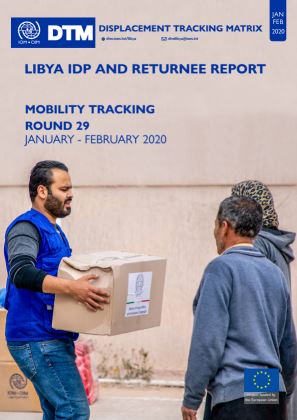
Contact
DTM Libya, DTMLibyateam@iom.int
Language
English
Location
Libya
Period Covered
Jan 01 2020
Feb 29 2020
Activity
- Mobility Tracking
- Baseline Assessment
This report presents the findings of Round 29 of the mobility tracking component of the Displacement Tracking Matrix (DTM) programme in Libya, covering the reporting period from January to February 2020. In Round 29, the number of internally displaced persons (IDPs) identified in Libya increased from 355,762 IDPs to 373,709 IDPs. New displacements during the reporting period were primarily due to continued armed conflict in western Libya and floods in Eastern Libya in Tobruk and surrounding areas in February*. Towards the end of the data collection cycle intensification in the conflict was reported in the areas of Sirt and Abu Gurayn, resulting in the displacement of over 4,650 individuals to surrounding areas. For further details on displacement from Abu Gurayn and from parts of Sirt
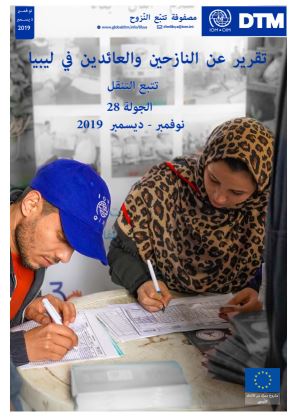
Contact
DTM Libya, DTMLibyateam@iom.int
Language
Arabic
Location
Libya
Period Covered
Nov 01 2019
Dec 31 2019
Activity
- Mobility Tracking
- Baseline Assessment
يستعرض هذا التقرير نتائج الجولة الثامنة والعشرين المستخلصة من عمل وحدة تتبّع التنقل الخاصّة بمصفوفة تتبع النزوح في ليبيا والتي تغطّي الفترة . الممتدة بين شهرس نوفمبر وديسمبر من سنة 2019 وخلال الجولة 28 ، ارتفع عدد النازحين داخليا في ليبيا من 343,180 نازحا إلى 355,672 نازحا. وتعود حالات النزوح الجديدة خلال الفترة المشمولة بالتقرير إلى تواصل الاشتباكات في غرب ليبيا )منطقة طرابلس والمناطق المجاورة لها)
Pagination
- Previous page
- Page 3
- Next page
